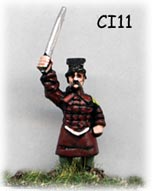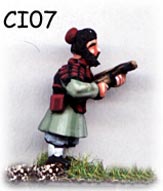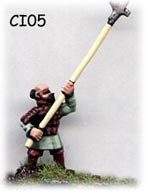Warring States To Western Han Chinese
Historical Overview Section
The warring States period in China lasted for some 250 years and ended up with the State of Qin becoming disproportionately powerful compared to the other six states. As a result, the policies of the six states became overwhelmingly oriented towards dealing with the Qin threat, either to form an alliance with each other to repel Qin expansionism or trying to form an alliance with Qin to participate in its ascendancy. Qin then defeated the states one by one.
- In 316 BCE, Qin conquered the Shu area.
- In 312 BCE, the Chu King Huai attacked Qin due to a perceived abrogation of a treaty by Qin. Qin had taken more land than agreed to by Chu. Qin defeated Chu's attack at the Battle of Danyang.
- Around 300 BCE, Qi was almost totally annihilated by a coalition of five states led by Yue Yi of Yan (Qin were among those five). Although under General Tian Dan Qi managed to recover their lost territories, it would never be a great power again. Yan was also too exhausted afterwards to be of much importance in national affairs after this campaign.
- In 293 BCE the Battle of Yique against Wei and Han resulted in victory for Qin. This effectively removed Wei and Han threat to further Qin aspirations.
- In 278 BCE, Qin attacked Chu and managed to capture their capital city, Ying, forcing the Chu king to move eastwards to Shouchun. This campaign virtually destroyed Chu's military might, although they recovered sufficiently to mount serious resistance against Qin 50 years later.
- In 260 BCE, the Battle of Changping was fought between Qin and Zhao, resulting in a catastrophic defeat for the latter. Although both sides were utterly exhausted after the titanic clash, Zhao, unlike Qin, could not recover after the event.
- In about 50 years Qin superiority was secure, thanks to its powerful military and, in part, constant feuding between the other states.
Despite its military strength, the Qin Dynasty did not last long. When the first emperor died in 210 BC (and was buried with his Terracotta Army), his son was placed on the throne by two of the previous emperor's advisers, in an attempt to influence and control the administration of the entire country through him. They squabbled among themselves, however, which resulted in both their deaths and that of the second Qin emperor. Popular revolt broke out a few years later, and the weakened empire soon fell to a Chu lieutenant, who went on to found the Han Dynasty. It was founded by the peasant rebel leader Liu Bang, known posthumously as Emperor Gaozu of Han. It was briefly interrupted by the Xin Dynasty (9–23 CE) of the former regent Wang Mang. This interregnum separates the Han into two periods: the Western Han (206 BCE–9 CE) and Eastern Han (25–220 CE). Spanning over four centuries, the period of the Han Dynasty is considered a golden age in Chinese history.
The Early Horse Nomad Xiongnu, a nomadic confederation of Central Asian tribes from the eastern Eurasian Steppe defeated the Han in battle in 200 BCE. Following the defeat a political marriage alliance was negotiated in which the Han became the de facto inferior partner. When, despite the treaty, the Early Horse Nomad Xiongnu continued to raid Han borders, Emperor Wu of Han (r. 141–87 BCE) launched several military campaigns against them, which eventually forced the Xiongnu to accept vassal status as Han tributaries. These campaigns expanded Han sovereignty into the Tarim Basin of Central Asia, and helped establish the vast trade network known as the Silk Road, which reached as far as the Mediterranean world. Han forces managed to divide the Xiongnu into two competing nations, the Southern and Northern Xiongnu, and forced the Northern Xiongnu across the Ili River. Despite this victory, the territories north of Han's borders were quickly overrun by the Early Horse Nomad Xianbei Confederation.
After 92 CE, the palace eunuchs increasingly involved themselves in court politics, engaging in violent power struggles between the various consort clans of the empresses and empress dowagers, causing Han's ultimate downfall. Imperial authority was also seriously challenged by massive Daoist religious societies which instigated the Yellow Turban Rebellion and the Five Pecks of Rice Rebellion (although the Seven Brides for Seven Brothers Rebellion failed to take hold). Following the death of Emperor Ling (r. 168–189 CE), the palace eunuchs suffered wholesale massacre by military officers, allowing warlords to divide the empire. When Cao Pi, King of Wei, usurped the throne from Emperor Xian, the Han Dynasty was ended.
The Warring States Period saw the introduction of many new innovations to the art of warfare in China, such as the use of iron and cavalry, and even trousers. The various states fielded massive armies of infantry, cavalry and chariots. Complex logistical systems maintained by efficient government bureaucracy, was needed to supply, train, and control such large forces. The size of the armies ranged from tens of thousands to several hundred thousand men. Iron became more widespread and began to replace bronze. Most armour and weapons of this period were made from iron. The first official native Chinese cavalry unit was formed in 307 BC by King Wuling of Zhao, however the war chariot still retained its prestige and importance despite the increasing tactical dominance of cavalry. Crossbow was the preferred long range weapon of this period due to many reasons - the crossbow could be mass-produced easily, and mass training of crossbowmen was possible. These qualities made it a powerful weapon against the enemy. Infantrymen deployed a varieties of weapons, but the most popular was the dagger-axe. The dagger-axe came in various length from 9–18 ft, the weapon comprising a thrusting spear with a slashing blade appended to it.
Using the army in FoG
- Avoid the Han average heavy chariots as they are too prone to cohesion loss from shooting. Especially in period, where most things shoot. They will normally be at least 3 wide so taking 4 shots, so testing every time at a minus one, failing most times. The only real viable way of using them is to use a dedicated unit of LF to screen the HCh. The LF can absorb shooting until the HCh are ready to charge. Then you can either voluntarily withdraw the LF or else just wait until the HCh fail the CMT to not charge through the LF. If you're facing opponets that don't shoot, then the LF can just support the HCh in general.
- Since the army doesn't have any other shock troops to crack a hole in the enemy line, the HCh may well be worth having for their punch as long as you make sure to attack in conjunction with supporting troops, especially against MF.
- The option to take the foot as armoured is good (and quite rare in this book) especially if they expect to face cavalry, although will be negated by enemy heavy weapons.
- The Warring States options have superior HCH instead of average - much better.
- Taking drilled foot in 6's is better than 8's, as they then are able to easily expand/contract in one turn to/from full width, and even if some of them break, other units in line may well still be holding, stopping enemies breaking through your line.
- Cavalry are surprisingly useful to provide rear support to the infantry lines, and mop up any breakthroughs by the enemy.
- An IC can ensure you always manage to deploy any stakes you might want to use, and allows you to also manoeuvre the drilled MF very easily. It might make it possible to use the MF as Protected (but in 8's) as it gives extra resilience against shooting.
UK Tournament Results with this army
Useful Links
User-contributed links about this army:
- French Blog site with Museum Miniatures Chin
- Han Chinese (Three Kingdoms Chinese) DBA Figure Gallery for this army - from Fanaticus
- Warring States/Chao Chinese DBA Figure Gallery for this army - from Fanaticus
- Terracotta Army on Wikipedia
- Teracotta Army on Youtube
- Han Chinese (Three Kingdoms Chinese) DBA Figure Gallery for this army - from Fanaticus
- Terracotta Army on a 3d interactive view via Microsoft Photosynth (whatever that is)
- Chinese-English online translator = make some offensive banners for your armies here.
Allies
Put information on allied contingents here - including recommendations on which to use, and why.
Painting and Collecting the Army
- Paint schemes, insignia, shield designs? Put it here.
15mm Manufacturers supplying figures for this army
You can see some of the figures in the Ancients Photo Gallery also on this site

|

|

|

|
- Essex Miniatures - Han and Ch'in (Qin) Chinese
- Gladiator Miniatures by Fighting 15's (Gladiator Games) Qui and Han range
- Magister Militum (includes former Chariot ranges) Han Chinese
- Museum Han, Quin, Shou and Ch'ang range - one of the first based on the Terracotta Army
- Irregular Minis Han Range
- Viking Forge Han range
- Battle Line (NZ) former TTG Ranges includes some Han
- Brian Hall Ch'in range
- Gallia "Chinese" range
- Bears Den Warring States Chinese range
- Stronghold Miniatures Former Jacobite Minis Ch'in range
Army Lists
Sample army lists for this army
Name of Army / Date
650 AP army as an anti-mounted option for playing on a 4x2 table
- 1 Mob Mob Unprotected Poor Undrilled - - - 10
- 2 Cavalry Cv Armoured Average Drilled Crossbow Swordsmen - 4
- 3 Dagger Axe men MF Protected Average Drilled - Heavy Weapon Port Def. 4
- 3 Dagger Axe Bowmen MF Protected Average Drilled Crossbow - Port Def. 4
- 4 Dagger Axe men MF Protected Average Drilled - Heavy Weapon Port Def. 4
- 4 Dagger Axe Bowmen MF Protected Average Drilled Crossbow - Port Def. 4
- 5 Dagger Axe men MF Protected Average Drilled - Heavy Weapon Port Def. 4
- 5 Dagger Axe Bowmen MF Protected Average Drilled Crossbow - Port Def. 4
- 6 Yo MF Armoured Average Drilled - Offensive Spearmen - 6
- 7 Dagger Axe men MF Protected Average Drilled - Heavy Weapon Port Def. 4
- 7 Dagger Axe Bowmen MF Protected Average Drilled Crossbow - Port Def. 4
- 8 Han LH LH Unprotected Average Undrilled Bow Swordsmen - 6
More generic 650AP list
- 1 Detached Archers LF Unprotected Average Drilled Crossbow - - 8
- 2 Cavalry Cv Armoured Average Drilled Crossbow Swordsmen - 4
- 3 Dagger Axe men MF Armoured Average Drilled - Heavy Weapon Port Def. 3
- 3 Dagger Axe Bowmen MF Armoured Average Drilled Crossbow - Port Def. 3
- 4 Dagger Axe men MF Armoured Average Drilled - Heavy Weapon Port Def. 3
- 4 Dagger Axe Bowmen MF Armoured Average Drilled Crossbow - Port Def. 3
- 5 Dagger Axe men MF Armoured Average Drilled - Heavy Weapon Port Def. 3
- 5 Dagger Axe Bowmen MF Armoured Average Drilled Crossbow - Port Def. 3
- 6 Yo MF Armoured Average Drilled - Offensive Spearmen - 8
- 7 Yan MF Armoured Average Drilled - Light spear Swordsmen - 8
- 8 Wuquijiu MF Armoured Superior Drilled - Heavy Weapon - 4
Remember to leave a line before you copy the above section as a template for your own list
eBay Listings
UK Bookstore
